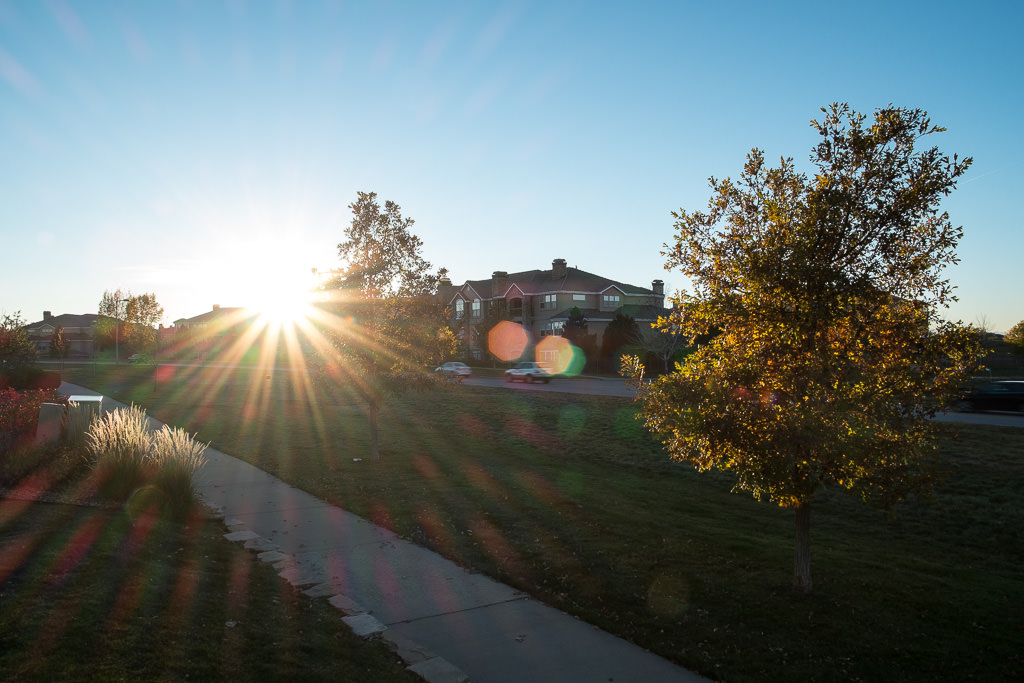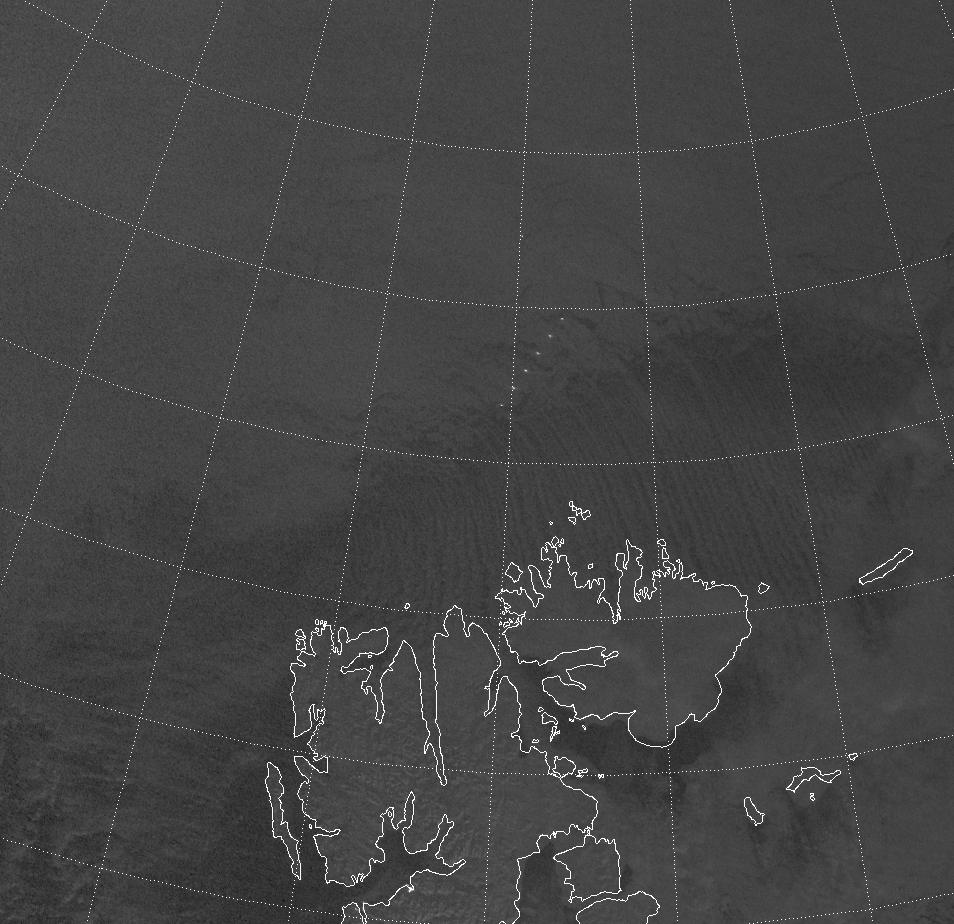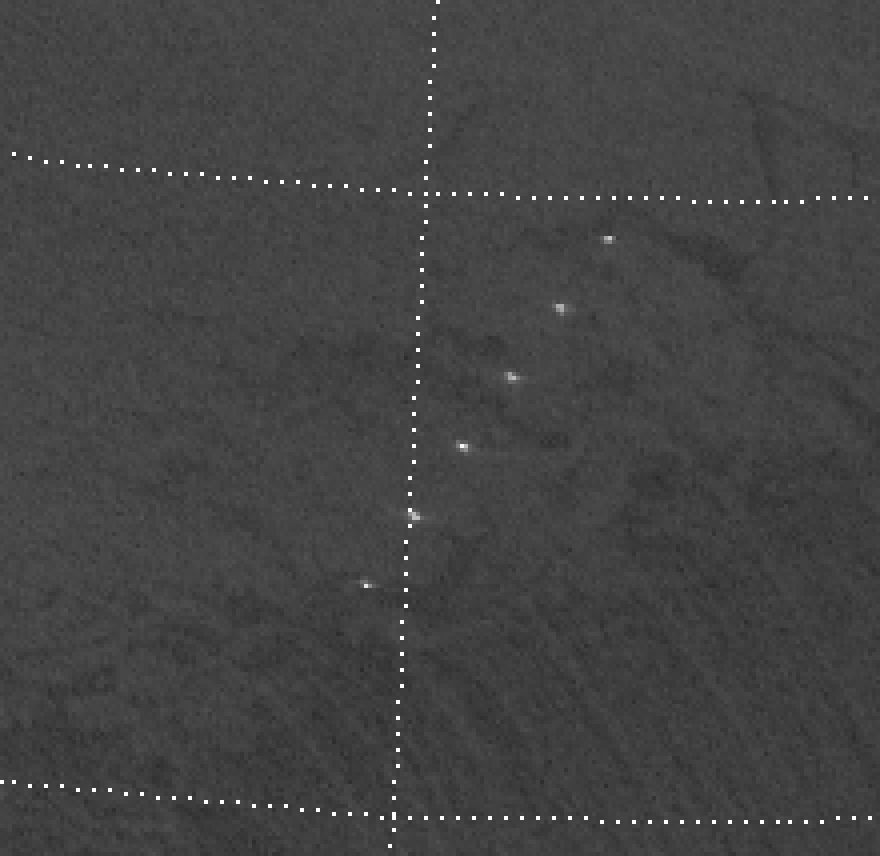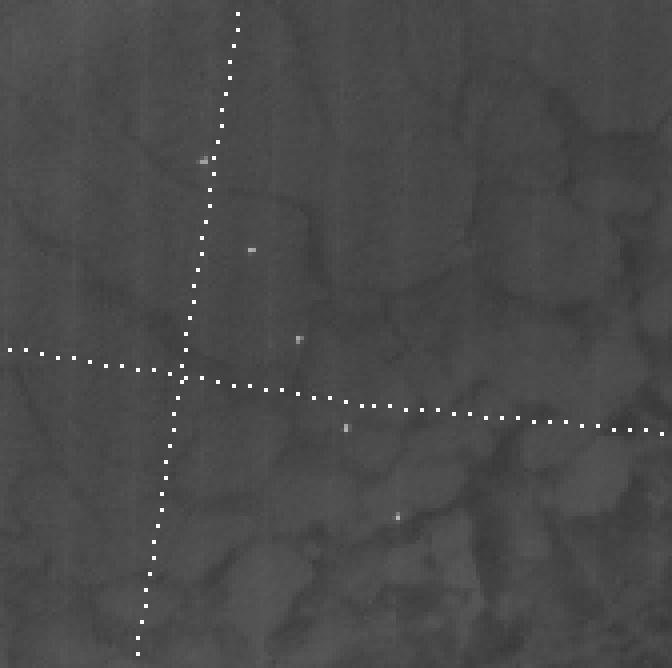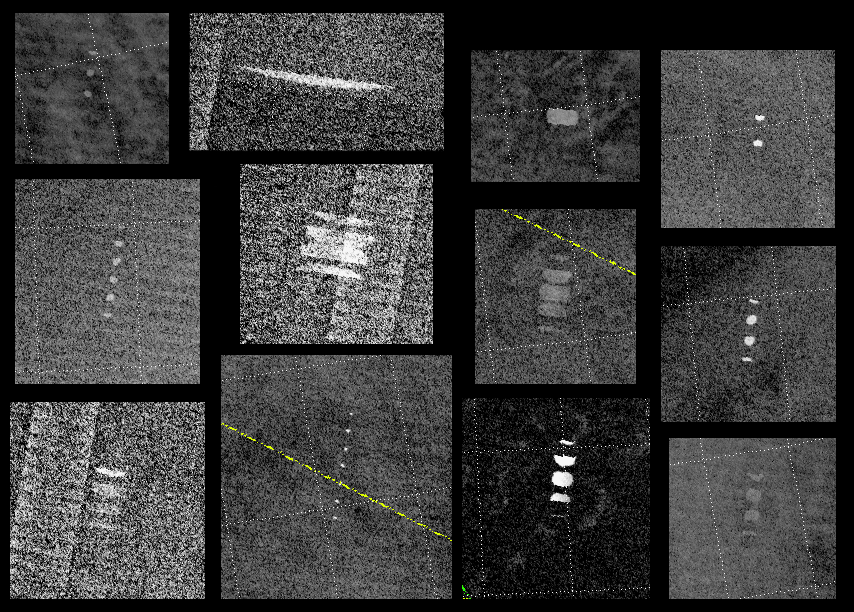It has been three years since the devastating Fort McMurray Fire – the costliest natural disaster in Canada’s recorded history. The city is still rebuilding. And, I’m sure the people of Alberta don’t want to be reminded of it. I hate to be the bearer of bad news but, here we go again! This time, it is the town of High Level, Alberta that has been evacuated. This is one of four “out of control” fires currently burning in Alberta:
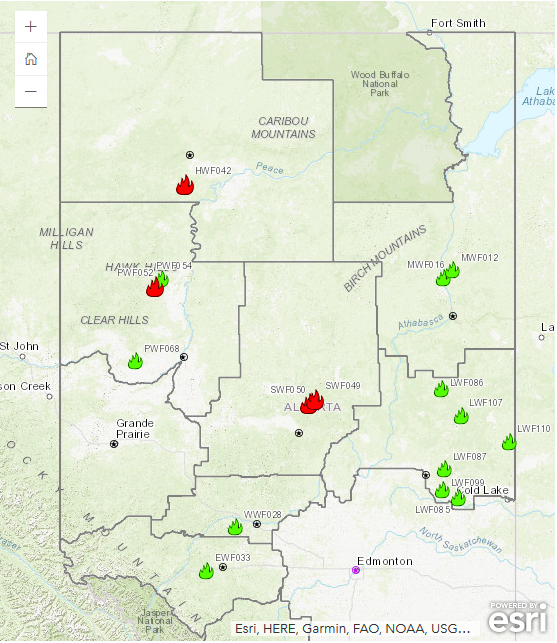
The red flame icons represent “out of control” fires, while the green ones are “under control”. This map was produced by Alberta Wildfire on 24 May 2019. The northernmost red flame represents the fire near High Level. According to Alberta Wildfire, the southern two fires started on 18 May 2019, while the other two started on 11-12 May 2019. But, as you shall see, they became out of control on 18 May.
This being Alberta, satellites are often the first source for spotting fires in these remote areas. Plus, Alberta is in a unique position: it is far enough east to be within the view of GOES-16 and far enough west to be within view of GOES-17. It is also far enough north to get several overpasses from VIIRS on both Suomi-NPP and NOAA-20 each day. So, what do these satellites have to say about these fires? Let’s take a look.
We’ll begin with GOES-16, which is now operational as “GOES-East” and has been since December 2017. Since April 2019, the GOES-16 ABI has been running in Mode 6 operations. This means full disk images every 10 minutes. Here is the GeoColor loop (link goes to PDF file) from GOES-16, starting at 1700 UTC on 18 May 2019 and running until sunset (~0400 UTC 19 May 2019):
For the uninitiated, GeoColor is a blend of true color imagery during the day with a low cloud/fog detection product at night. True color is particularly useful for detecting smoke, as we have seen before. So, did you see it in the above loop?
I’ll admit, the clouds make it difficult to see, but there are two smoke plumes visible in that video. (It helps to view the video in full screen mode.) The smoke plume for the fire near High Level shows up first (around 1940 UTC), then the smoke from the pair of fires northeast of Lesser Slave Lake appears around 2150 UTC and become obvious around 0000 UTC on 19 May.
Here is the Fire Temperature RGB from GOES-16 ABI over the same time period:
This product is sensitive to hot spots – not smoke – but it still has an issue with clouds, which block the signal. Notice that the northernmost fire near High Level first appears in the Fire Temperature RGB around 1840 UTC – an hour before the smoke is really evident. The first fire northeast of Lesser Slave Lake is visible starting at 2200 UTC (10 min. after the smoke is visible), and the second one first appears at 2320 UTC (about 20 min. after its smoke plume appears). The fourth fire (the westernmost of all of them, and the one in the middle north-to-south) first appears at 2100 UTC, although it is in and out of the clouds, and its smoke plume is never very visible.
Compare that with GOES-17 ABI, which is now operational as “GOES-West” (since February 2019), and is also running Mode 6 operations:
These videos cover the same time period as the GOES-16 versions.
Moving clockwise starting at the fire near High Level, the first sighting of smoke according to GOES-17 is around 1900 UTC, 2200 UTC (first Lesser Slave Lake fire), 0000 UTC (second Lesser Slave Lake fire), and 2310 UTC (westernmost fire). This is 40 min. earlier, similar to, similar to, and not easily comparable to GOES-16. (Since GOES-16 never got a clear look at the smoke from the westernmost fire, it’s difficult to compare times against GOES-17, which was able to detect smoke from that fire. Also, I say a 10 minute difference is “similar to”, since it is a judgement call as to which image an analyst would confidently say they first saw the smoke or the hot spot.)
Comparing the hot spots in the same clockwise fashion, the time of first detection was 1820 UTC, 2140 UTC, 2320 UTC and 2050 UTC. This is 20 min. earlier, 20 min. earlier, similar to, and similar to GOES-16. If you don’t believe me, compare them frame by frame in this video:
GOES-16 is on the right and GOES-17 is on the left. When you can directly compare them like this, a few things jump out. 1) The fire near High Level appears to grow more in GOES-17 than it does in GOES-16. 2) The two fires near Lesser Slave Lake appear so close together in GOES-17 that they are difficult to distinguish as separate fires, although they are clearly separate fires according to GOES-16. 3) The westernmost fire is the most difficult to see due to the presence of clouds.
Here, it is important to note a few things. A) Alberta is generally closer to GOES-17 than it is to GOES-16. B) The position the clouds and the motion of the fire relative to the lines of sight of the satellites lead to significant differences between GOES-16 and GOES-17 in this case. C) The plural of “anecdote” is not “data”. The exact circumstances that apply here are not going to apply in the future but the concepts still will.
The fire near High Level moves perpendicular to the GOES-17 line of sight, and moves parallel to the GOES-16 line of sight (away from the satellite on a curved surface to boot!) with slightly more coarse resolution in GOES-16. That explains the differences in apparent motion between the two views. The differences in viewing angle also explain why the fires near Lesser Slave Lake appear separate (GOES-16) or together (GOES-17). And, clouds blocking the line of sight explain why the fire near High Level appears later in GOES-16, while GOES-17 had a clear view of the fire 20 minutes earlier. The differences in perspective offered by the two satellites also make it tough to tell which fire is furthest west (the one I’ve been calling “westernmost”).
Both geostationary satellites are viewing Alberta at a high angle. What about VIIRS on Suomi-NPP and NOAA-20, which flies more-or-less directly overhead? Since these satellites are polar-orbiting, they can’t provide 10 min. imagery of the fires. But, they do combine to provide ~50 min. imagery of the fires for a few orbits in the early afternoon and early morning hours, and they have much better spatial resolution.
The first VIIRS overpass was from NOAA-20 at around 1920 UTC, and here’s what it saw (according to the Fire Temperature RGB):

This image is about an hour after GOES-17 first spotted the fire near High Level, which is the most obvious fire in the scene. In fact, the westernmost fire is hidden under the clouds and the fires near Lesser Slave Lake haven’t started yet. The closest time matched images with both GOES are provided below.

Approximately 50 min. later, Suomi-NPP passed overhead and provided this view:

And the GOES view from approximately the same time:

Here the fire near High Level is quite a bit more intense, as you could see if you were to toggle back and forth between the two VIIRS images. This is a definite sign that the fire is a dangerous one! Still no sighting of the Lesser Slave Lake fires, which didn’t get going for another 110 minutes or so, according to both GOES. There was another NOAA-20 overpass at 2101 UTC, then a Suomi-NPP overpass that caught the western portion of the scene at 2151 UTC. Combine all four overpasses in an animation, and you get this:

Remember to click on the image to get the animation to play. If you look closely, you can see both of the fires northeast of Lesser Slave Lake in the NOAA-20 image from 2101 UTC – a full 50 minutes earlier than either GOES was able to detect them. But, they are just single pixels at this point, making them likely too small for ABI to detect them (particularly at such a high viewing angle).
As for the smoke, it’s not any easier to detect with VIIRS given all the clouds overhead (click to play):

You might have noticed in the above animation that Lake Athabasca is still covered in ice, which is not apparent in the Fire Temperature RGB. That means fire season in Alberta started before all the ice had melted!
Over the next few days, clouds weren’t as much of a problem so the hot spots and smoke plumes were easily visible from all four satellites. Here are direct comparisons between GOES-16, GOES-17 and the two VIIRS for 19 May 2019:




We can even do better than that and really zoom in:
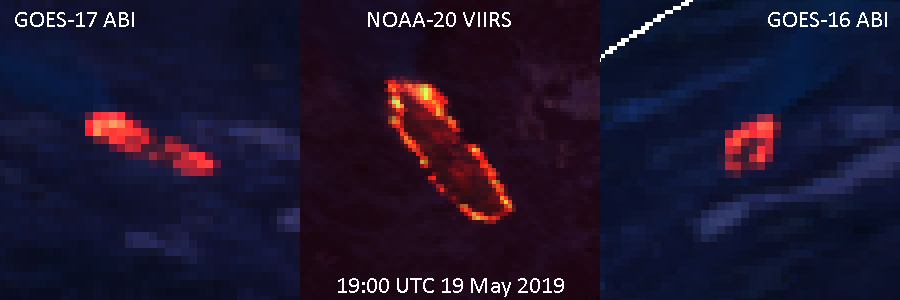
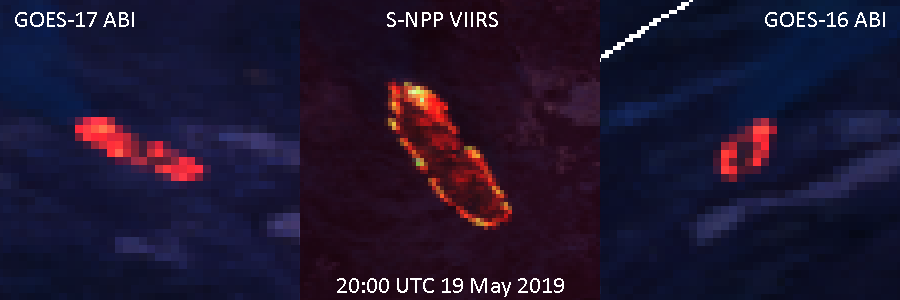
Here, the previous images have been cropped to the fire near High Level, and zoomed in 400%. The difference in resolution between VIIRS and ABI at this latitude is obvious.
Here is a four day loop of True Color RGB images from both VIIRS (click to play):

And, click on these links for similar loops of GeoColor from GOES-16, GOES-17 and a side-by-side comparison of the two. (The videos are too large to embed here.)
And, finally, here is a four day loop of Fire Temperature RGB images from both VIIRS (click to play):

And links to MP4 video files from GOES-16, GOES-17 and a side-by-side comparison of the two.
